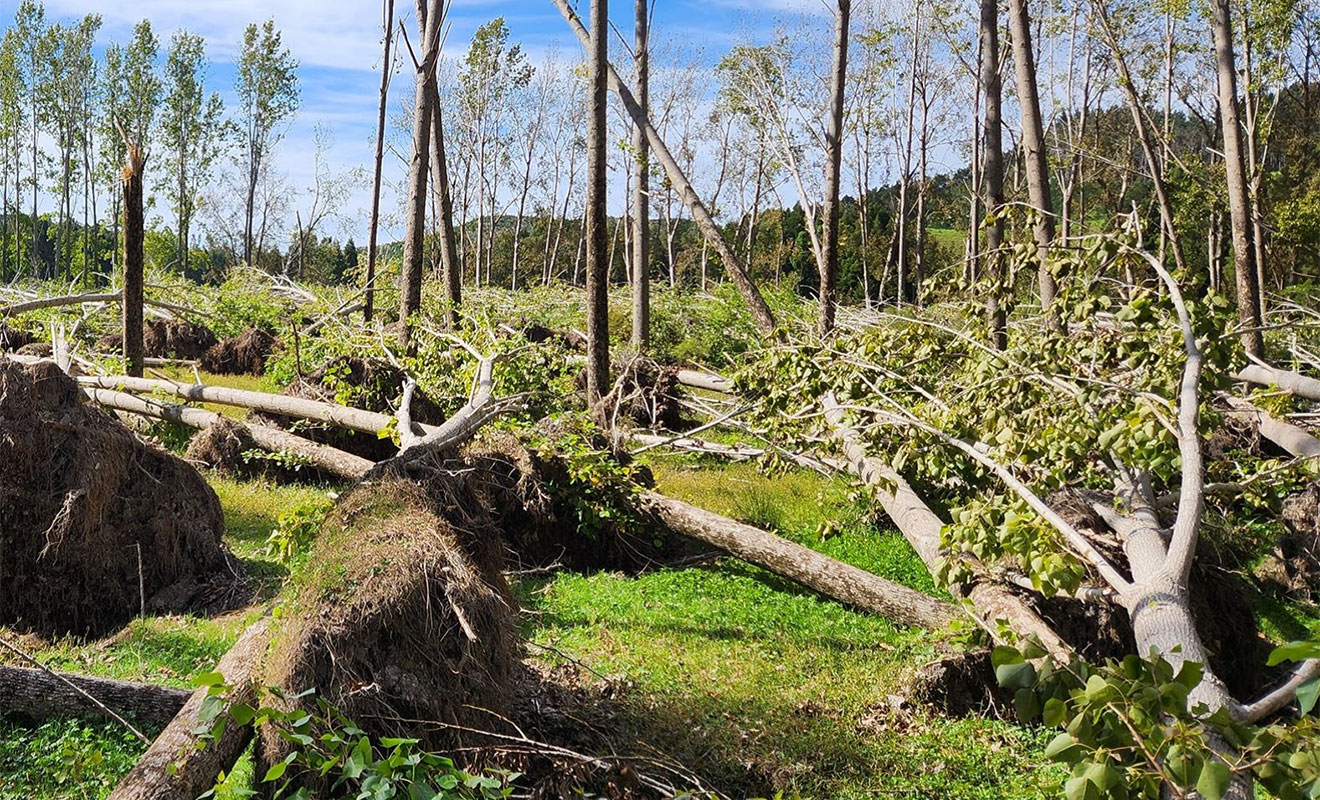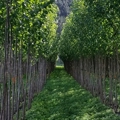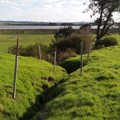Planting poplars and willows for soil conservation
We support landowners with subsidised poplars and willows and a subsidy to help fund planting costs if you are planting NRC poplars or willows for erosion control.
Northland Regional Council grows and supplies poplars and willows for erosion prone land from our nursery in Mata, south of Whangārei.
Poplars and willows grow readily from cuttings, so our trees are supplied as bare stems with no roots or branches. These are commonly referred to as ‘poles’, ‘stakes’ or ‘wands’, depending on their age and length.
People often ask us questions about poplars and willows. Here are the answers to some of the frequently asked questions.
Although poplars and willows are not native species, they have a useful role to play in rapidly controlling erosion. This is because they grow quickly and have extensive root systems that bind soil, helping to prevent soil movement and loss.
The root structure of poplars makes them better suited to controlling hill country erosion, whereas willows are well suited to controlling gully and streambank erosion. Willows have a fine root mat structure that protects banks from undercut and scouring. They are adapted to growing beside waterways, can survive with part of their root system submerged in flowing water, and are resilient to floods. In addition, survey data shows they provide good habitat for eels/tuna.
It's important to remember there is no ‘perfect tree’ and no ‘one size fits all’ approach – each site is unique. The best tree to choose depends on what you want it to do, where you want to plant it, and what’s important to you as a landowner. It’s not simply a choice between natives or exotic poplars and willows – both have roles to play.
For example, we generally recommend planting natives around waterbodies, but suitable willow varieties can be used in areas where erosion is severe. Willows can quickly stabilise eroding stream or river banks while native trees establish and thrive in the long term.
Some native species, such as totara and kanuka, can provide effective erosion control in pastureland. Totara are wind resistant as well as doing a good job of stabilising soil. However, poplars have some advantages over these native species:
- Totara grow much more slowly than poplars – it takes 40 years or more for a totara to provide the same level of erosion control as a poplar can after only 15 years.
- Poplars work better within a farming system:
- Totara and kanuka need to be planted more densely than poplars to achieve the same level of erosion control, which reduces grass growth.
- Natives facilitate the reversion of pasture back into forest, making the planted land less useful to farmers as pasture.
- Poplars lose their leaves in winter, allowing more light onto pasture at this time of year.
- Poplar leaves can provide livestock feed in times of drought.
Both poplars and willows can be used as an initial stabiliser to support a transition to slower-growing native species. Whereas our modern poplar and willow varieties are sterile, natives do set seed and planted areas may begin to revert to forest, so you will need to decide how you wish to use the target area before you choose to interplant.
Poplars grow better timber and are safer as large trees if they are pruned properly while young:
- Prune to a single leader at Year 3 if the tree is growing well, or Year 4 if it’s growing slowly or in an exposed area.
- Prune the two lower whorls of branches two years after the first pruning. Every year thereafter prune off a whorl of branches up to a height of six metres, making sure to retain three major whorls for the crown.
- Remove steeply angled vigorous branches as early as possible, as these are likely sites for splitting in mature trees. Prune in autumn to minimise regrowth.
Trees that are not pruned are more vulnerable to wind damage, and dense stands can shade out grass growing underneath.
Thinning out small or sick trees is also recommended to keep your stand healthy.
The root structure of poplars makes them better suited to controlling hill country erosion, whereas willows have a root mat structure that is well suited to controlling gully and streambank erosion.
We don’t recommend planting poplars to stabilise stream or river banks. Their root structure is better suited to controlling hill slope erosion.
We generally recommend planting natives around waterbodies, with ribbonwood, cabbage trees, and pittosporum being good choices.
Suitable willow varieties can be used in streambank areas where erosion is severe. Willows can quickly stabilise eroding stream or river banks while native trees establish and thrive in the long term .
Historical planting of willows from the 1960s to the 1980s has caused problems with branches breaking off and growing downstream. These trees were brittle willow species, such as crack and grey willows. We do not grow crack or grey willows. The modern willow varieties we supply have flexible branches that don’t easily break off. They are sterile and don’t set seed. These characteristics help to prevent unwanted new trees.
Yes. The Hill Country Erosion Fund is a contestable fund that subsidises native tree planting projects on highly erodible pastureland. Projects must plant at least two hectares, at 2,000 stems per hectare. This fund runs until winter 2026 for planting projects.
Applicants need to make their own arrangements to get the plants in the ground, with council reimbursing costs of $4,326 per hectare, plus GST for applicants who are GST registered.
For more information, contact a Northland Regional Council land management advisor on 0800 002 004 or email: [email protected]
Our poplars and willows are sterile and do not set seed. In addition, the willows we provide have flexible branches to reduce the risk of branches breaking off and growing new trees.
Some cultivars (varieties) of poplar do grow suckers, which are new shoots growing from the same roots as the main tree trunk. This most often happens when the roots are disturbed, such as when eroding land moves. Suckering can be a useful trait, because land movement stimulates the growth of new trees to help control erosion.
The Ngā Manga Atawhai Project might be able to help.
Formed in the aftermath of Cyclone Gabrielle, Ngā Manga Atawhai pulls together groups from across government, councils, iwi, and the private sector to enable the removal of dangerous trees. Most of the wood is processed and provided to low-income whānau as firewood to warm their homes.
The project targets trees that have fallen or are causing a risk to powerlines or other infrastructure.
Please contact Te Roroa on 09 439 6443 to discuss whether the project can assist you.
In general, fallen or at-risk trees on private property are the responsibility of the landowner.
For many years, NRC’s main tool to manage erosion in pasture has been planting poplar trees. This is because poplars are fast growing and have extensive root systems that help hold the soil in place, allowing erosion prone farmland to stay in pastoral production.
Extreme weather events such as Cyclone Gabrielle can have severe impacts on our environment and the event in February took its toll on some poplar plantings. Land Management staff at NRC toured some areas of Northland where Cyclone Gabrielle caused the most extensive damage to poplar trees, to try to gain a better understanding of why those particular trees were more impacted than others.
Key points noted were that Cyclone Gabrielle was an extreme wind event that came after an unusually wet summer, so the combination of severe winds with highly saturated soil conditions resulted in localised windthrow of poplar. Because poplars grow fast, tend to be planted in wetter areas and were in full leaf at the time the cyclone hit, they appear to have suffered more windthrow than other tree species in Northland.
As Kawa has been the main poplar variety planted in Northland since the 1980s, the majority of windthrow was Kawa. Levels of windthrow varied across the region, but we only visited locations that were extensively damaged. In many locations, Kawa was unaffected by the cyclone.
Cyclones are unpredictable as to where they land and the direction of wind. While localised wind severity and turbulence can’t be planned for, some broad-brush contingencies will increase windthrow resilience, including:
- Poplar forest design should prioritise the main need e.g., erosion control, shade and shelter etc, with timber production secondary.
- Avoid planting Kawa in poorly drained areas with weak soil strength, especially if a plantation crop.
- Set poplar back from drain and stream edges (at least 3-5m from the top edge of the bank).
- When growing poplar for timber, rooted cuttings are planted at up to 1,000 stems per hectare (STP). However, at this stocking trees are tall and thin which increases their vulnerability to windthrow. To reduce the risk of this happening, poplar stands should be thinned down to a final spacing of 250-300 STP (6m x 6m), similar to a radiata regime.
Kawa has been a proven performer for Northland conditions. However, it appears Kawa is more vulnerable to cyclones than other clones such as Veronese. One reason for this may be smaller root plates compared to other poplar varieties. Northland Regional Council is conducting field trials on a range of poplar varieties to determine their suitability for Northland conditions. In addition to rust resistance, possum resistance, quality timber and good form, resistance to windthrow is an important selection criterion for future breeding and selection programmes.
Read the full report: Poplar windthrow following Cyclone Gabrielle

Extensive damage to poplar trees caused by Cyclone Gabrielle.



